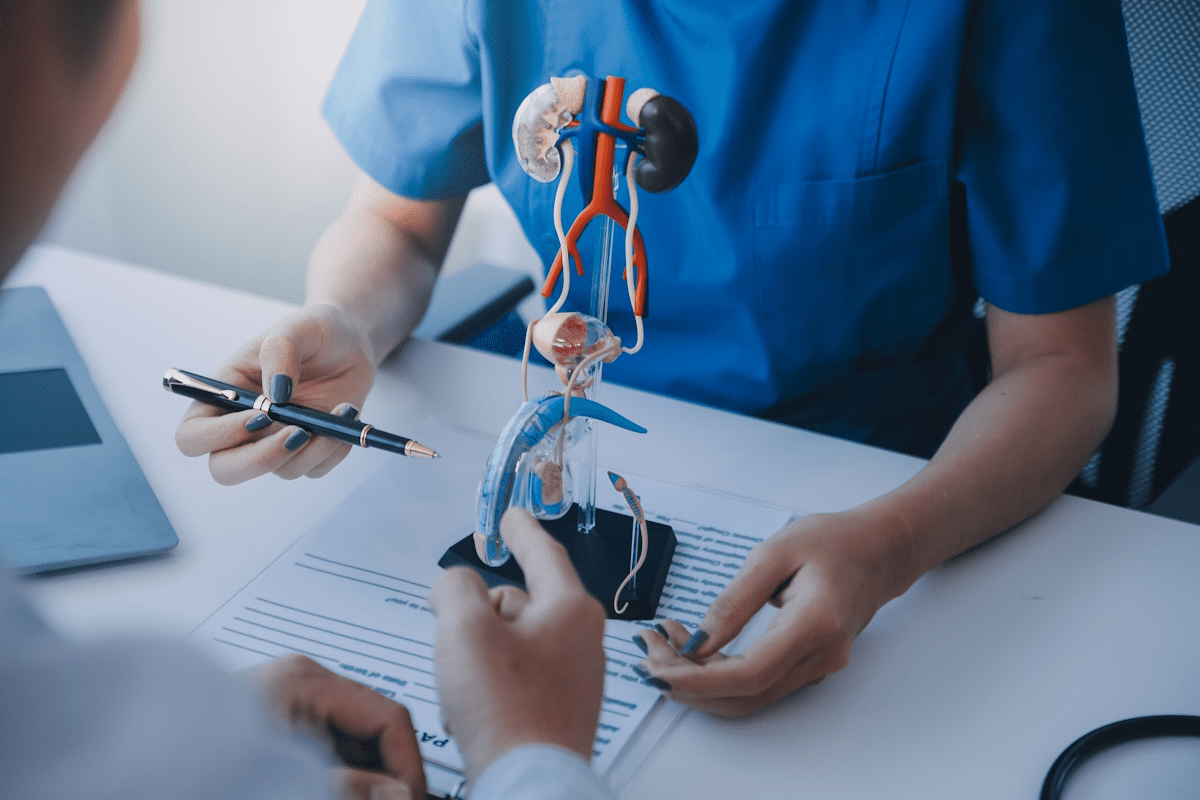Last Updated on November 26, 2025 by Bilal Hasdemir

Having a heart cath procedure with stents can be scary. It’s important to follow the right recovery steps for a quick and easy recovery. Doctors often tell patients to stick to certain restrictions to help them heal fast and safely. Get the 7 critical restrictions after heart cath with stents. This quick recovery guide is essential for your safety and healing.
Medical experts, like the a Medical organization Staff, say patients should rest and avoid hard work after the procedure. They advise not to do hard exercise or lift heavy things for at least 24 hours after coronary angioplasty and stenting.
At Liv Hospital, we help you understand the 7 key restrictions to follow after a heart cath with stents. This way, you can get back to your usual life quickly. By sticking to these rules, you can lower the chance of problems and make sure you heal safely.
Key Takeaways
- Rest and avoid strenuous activities for at least 24 hours
- Avoid heavy lifting and strenuous exercise
- Follow a healthy diet and lifestyle
- Attend follow-up appointments with your doctor
- Monitor your condition and report any concerns
What Happens During and After a Heart Catheterization Procedure

Knowing about the heart catheterization process and what happens after is key for a good recovery. A catheter is put into a blood vessel, usually in the groin or arm. It’s then guided to the heart to diagnose and treat heart issues.
The Stent Placement Process
A big part of the procedure is putting in a stent. A stent is a small, mesh-like device that keeps the artery open. This improves blood flow to the heart.
The stent is placed by:
- Guiding a catheter with a balloon to the narrowed artery
- Inflating the balloon to open the artery
- Placing the stent to keep the artery open
This helps restore normal blood flow. It reduces symptoms like chest pain and shortness of breath.
Immediate Post-Procedure Effects
After the procedure, you’ll be in a recovery area where you’ll be watched for any immediate issues. You might feel some discomfort or bruising where the catheter was inserted. Our medical team will give you specific care instructions.
| Common Post-Procedure Effects | Care Instructions |
| Bruising or discomfort at the insertion site | Apply ice packs and rest |
| Fatigue | Rest and avoid strenuous activities |
| Potential bleeding | Monitor the site and report any heavy bleeding |
Initial Recovery in the Hospital
The first few hours in the hospital are critical for your safety and the success of the procedure. Our healthcare team will watch your condition closely. They’ll check for any complications and manage any pain.
You’ll need to lie flat for a few hours to prevent bleeding. We’ll also give you instructions on post-procedure care. This includes managing your medication, activity levels, and follow-up appointments. It’s important to follow these instructions carefully for a smooth recovery.
Key Restrictions After Heart Cath With Stents: The Complete List

Knowing the rules after a heart cath with stents is key to avoiding problems and helping you heal. Your doctor will give you clear instructions to follow during your recovery.
Why These Restrictions Matter
The rules after a heart cath with stents aim to prevent issues like bleeding, infection, or stent blockage. By sticking to these guidelines, you help your body heal right and keep the stent open for blood flow.
It’s very important to follow these rules for a safe and good recovery. A top cardiologist says, “It’s vital to follow the post-procedure instructions to avoid problems and make sure the stent works right.”
How Long Restrictions Typically Last
The length of these rules can change based on many things. These include the type of procedure, how many stents were used, and your health. Some rules might last a few days to a week, while others could be for weeks or even months.
- Immediate post-procedure restrictions (first 24-48 hours)
- Short-term restrictions (1-2 weeks)
- Long-term recommendations (several weeks to months)
Personalized Restrictions Based on Your Condition
It’s important to remember that the specific rules for you will depend on your unique situation. Your doctor will look at your medical history, the complexity of the procedure, and any other health issues you have.
“Each patient’s recovery plan is unique and based on their specific needs and health status,” says a cardiology expert. “It’s vital to follow the personalized instructions provided by your healthcare team.”
By understanding and following these rules, you can make your recovery better and lower the chance of complications.
Restriction #1: Physical Activity and Lifting Limitations
After a heart cath with stents, it’s important to limit physical activity. This helps prevent complications and lets your body heal. Strenuous activities can slow down the healing process.
Weight Lifting Restrictions
Avoid heavy lifting for 24 to 48 hours after the procedure. This means no lifting objects over 10-15 pounds (4.5-6.8 kg). Heavy lifting can cause bleeding or other issues at the catheter site.
Guidelines for Daily Movement
While you should avoid heavy lifting, gentle movement is okay. Short walks are good, but avoid hard exercise or bending.
Safe Exercise Options During Recovery
In the early stages, stick to low-intensity activities like walking or light stretching. Avoid intense workouts like running, cycling, or weight training until your doctor says it’s okay.
Gradual Return to Normal Activities
As you get better, you can start doing more things. But listen to your body and don’t rush. If you feel pain or discomfort, stop right away and talk to your doctor.
Following these guidelines is key to a good recovery after a heart cath with stents. By sticking to these post cardiac cath instructions, you can avoid complications and have a smooth recovery time for heart cath procedures. Proper post heart cath care means being careful with your physical limits and slowly getting back to normal.
Restriction #2: Incision Site Care Protocol
After a heart cath with stents, taking care of the incision site is key. It helps avoid infection, speeds up healing, and lowers the chance of problems.
Keeping the Insertion Site Clean and Dry
Wash the incision site with mild soap and water 24 hours after the procedure. Don’t soak the area in water, like taking a bath or swimming, until your doctor says it’s okay.
Key steps to follow:
- Gently pat the area dry with a clean towel.
- Avoid using harsh soap or other cleansers that may irritate the skin.
- Keep the area dry for at least 24 hours post-procedure.
Bandage Management and Removal
Your healthcare provider will tell you how to manage and remove the bandage. Keep the bandage clean and dry. If it gets wet or dirty, change it for a new, clean one.
Managing Bruising After Cardiac Catheterization
Bruising at the insertion site is common after cardiac catheterization. To manage bruising, apply a cold compress to the area for 15-20 minutes, several times a day. Elevate the affected limb if bruising is significant.
Warning Signs of Infection or Complications
Watch the incision site for signs of infection or complications, like increased redness, swelling, drainage, or fever. If you notice these symptoms, call your healthcare provider right away.
| Signs to Monitor | Action to Take |
| Increased redness or swelling | Contact your healthcare provider |
| Drainage or pus from the incision site | Seek immediate medical attention |
| Fever or chills | Notify your healthcare provider |
Restriction #3: Essential Medication Management
After a heart cath with stents, managing your medications is key to a good recovery. Your healthcare team will give you a list of medicines. These are to stop blood clots and keep the stent open.
Understanding Your Antiplatelet Therapy
Antiplatelet therapy is a big part of your medicine plan. It stops platelets in your blood from clumping together. This is important to stop the stent from getting blocked. You might take aspirin or P2Y12 inhibitors like clopidogrel.
The time you take antiplatelet therapy can change. But usually, it’s for at least 12 months after getting a stent. Your doctor will tell you how long based on your situation and the stent type.
Importance of Medication Adherence
It’s very important to take your medicines as told. Not taking them or changing doses without your doctor’s okay can cause big problems. Like stent thrombosis. Try setting reminders or using a pill box to help you remember.
Potential Side Effects to Monitor
Antiplatelet therapy is usually safe, but watch out for side effects. Bleeding is the main risk. This can show up as bruises, nosebleeds, or bleeding gums. If you see any unusual or bad bleeding, call your doctor right away.
Supplements and Over-the-Counter Medications to Avoid
Some supplements and over-the-counter medicines can mess with your antiplatelet therapy. Don’t start any new medicines or supplements without talking to your doctor. Be careful with NSAIDs like ibuprofen and herbal supplements like ginkgo biloba and fish oil.
By managing your medicines well and knowing about possible interactions, you can lower risks. This helps your recovery after a heart cath with stents.
Restriction #4: Driving and Travel Considerations
After a heart cath with stents, knowing the rules for driving and travel is key. Your doctor will give you specific advice based on your health. But here are some general tips to follow.
When You Can Safely Drive Again
Usually, you shouldn’t drive for at least 24 hours after a heart cath. The procedure might make you feel tired or uncomfortable because of the medicine. Also, there’s a small chance of bleeding at the catheter site, which could be risky while driving.
Before you start driving again, make sure:
- You’ve stopped taking sedatives or other medicines that could affect your driving.
- You’re not in too much pain or discomfort that could distract you.
- Your doctor says it’s okay for you to drive.
Air Travel After Stent Placement
Flying after a heart cath with stents needs careful thought. There’s no strict rule against flying, but it’s wise to avoid it for a bit unless you really have to.
Here’s what to think about when planning to fly:
| Time Frame | Recommendation |
| First 24-48 hours | Avoid flying if you can. |
| After 48 hours | Talk to your doctor; they might say not to fly for up to a week. |
Long-Distance Travel Precautions
Traveling far by car or plane can raise the risk of blood clots because you’ll be sitting for a long time. If you must travel, follow these tips:
- Get up and stretch regularly.
- Drink lots of water to stay hydrated.
- Wear compression stockings to lower the risk of DVT.
Medical Documentation for Travel
When you travel after a heart cath with stents, it’s smart to carry medical papers. These should include:
- A letter from your doctor explaining your health and any medicines you’re taking.
- Details about your procedure, like the date and type of stents.
- How to reach your doctor and any important medical records.
Having this paperwork can help in case of a medical emergency while you’re away.
Restriction #5: Returning to Work and Daily Routines
After a heart cath with stents, getting back to work and daily life needs careful planning. Your healthcare team will guide you on when it’s okay to start again. They consider your health and job type.
Timeline for Different Types of Employment
The time to go back to work changes based on your job. Desk jobs might let you return in a few days to a week, if all goes well. But jobs that are hard on your body might take 1-2 weeks or more. This depends on your job and how you’re healing.
“Listen to your body and don’t rush back,” says Medical Expert, a cardiologist. “It’s important to find a balance between getting back to normal and not pushing too hard.”
Workplace Accommodations to Request
When you go back to work, you might need some special help. This could be things like flexible hours, lighter workloads, or changes to your job to avoid hard work. It’s key to talk about what you need with your boss.
- Flexible working hours to manage fatigue
- Temporary reduction in workload
- Adjustments to job duties to avoid strenuous activities
Managing Household Responsibilities
Handling home tasks while recovering can be tough. Getting help from family and friends for things like cooking and cleaning is a big help. Focusing on the most important tasks can also make things easier.
Heart Cath Procedure Recovery Milestones
Knowing what to expect during recovery can be helpful. Most people start to feel better in 1-2 weeks. It usually takes 4-6 weeks to get back to most normal activities. But, this can change based on your health and any complications.
By following your healthcare team’s advice and listening to your body, you can get through recovery well. This way, you can safely get back to your daily life.
Restriction #6: Intimacy and Sexual Activity Guidelines
After a heart cath with stents, many wonder when they can safely have sex again. Intimacy is key in many lives, and it’s normal to worry about it after a medical procedure.
How Long After Heart Cath Can You Have Intercourse
Doctors usually say wait a few days to a week before sex. This gives your body time to heal. The exact time depends on your health and the procedure details.
Key factors to consider:
- The presence of any complications during or after the procedure
- Overall health and physical condition
- Specific instructions from your healthcare provider
Signs to Stop Activity Immediately
Know your body’s signals during sex. If you feel any of these, stop right away and get medical help:
- Chest pain or discomfort
- Shortness of breath
- Dizziness or fainting
- Severe headache or confusion
Communicating With Your Partner About Limitations
Talking openly with your partner is key during recovery. Share your limits, worries, and any pain. This helps manage expectations and lowers anxiety.
Tips for discussing intimacy:
- Be honest about your feelings and physical limitations
- Explore alternative forms of intimacy that don’t strain your body
- Reassure your partner that your caution is a part of your recovery process
Medications That May Affect Sexual Function
Some heart cath meds, like beta-blockers, can impact sex. Talk to your doctor about any worries. They can adjust your meds if needed.
Common issues to discuss:
- Erectile dysfunction
- Changes in libido
- Other sexual health concerns
Getting back to intimacy after a heart cath with stents takes patience, understanding, and talking. By following your doctor’s advice and listening to your body, you can confidently move forward in your recovery.
Post Heart Cath Care: Follow-Up Appointments and Monitoring
After a heart cath with stent placement, follow-up appointments are key. They help track your recovery and catch any problems early.
Scheduling and Attending Follow-Up Visits
Your doctor will set up a follow-up visit soon after. It’s important to go to these appointments. They let your doctor:
- Check how the catheter site is healing
- Look at how your heart and stent are doing
- Change your meds if needed
- Talk about any issues or symptoms
Going to all your scheduled visits helps your recovery go smoothly. Be ready to talk about your progress and any problems.
Tests to Expect During Follow-Up
At your follow-ups, your doctor might do several tests. These include:
- Electrocardiogram (ECG) to check your heart’s rhythm
- Stress test to see how your heart works under stress
- Blood tests to check your cholesterol and meds
- Imaging tests like echocardiograms to see your heart’s shape and function
These tests give your healthcare team a full picture of your heart. They help make the best decisions for your care.
Cardiac Rehabilitation Programs
Your doctor might suggest a cardiac rehab program. These programs include:
- Exercise training to boost heart health
- Nutrition advice for heart-healthy eating
- Stress management to lower emotional stress
- Education on heart health and managing risks
Joining a cardiac rehab program can greatly improve your recovery. It also lowers the chance of future heart issues.
Long-Term Stent Monitoring
After getting a stent, it’s important to keep an eye on it. Your doctor will want to see you regularly. They might use imaging tests to check the stent’s work over time.
By following your doctor’s advice for follow-up care and monitoring, you can get the best results after your heart cath with stents.
Conclusion
Recovering from a heart cath with stents needs careful following of guidelines. By sticking to these rules, you can recover safely and quickly.
Remember to go to all follow-up appointments and watch your health closely. This is key for spotting any problems early.
We’ve given you a detailed guide on what to do after a heart cath with stents. By following this advice, you can avoid risks and recover smoothly.
Your health is our main concern. By being aware of the rules after a heart cath and actively caring for yourself, you can have a full recovery.
FAQ
What are the key restrictions after a heart cath with stents?
After a heart cath with stents, you should limit physical activity. Avoid heavy lifting. Keep the incision site clean and dry. Follow your medication schedule closely.
Also, wait a bit before driving and traveling. You’ll need to adjust your work and daily routines. And, there are guidelines for intimacy and sexual activity.
How long do I need to avoid heavy lifting after a heart cath?
The time to avoid heavy lifting varies. Usually, it’s a few days to a week. Your healthcare team will give you specific advice.
How do I care for the incision site after a heart cath?
Keep the incision site clean and dry. Manage the bandage as instructed. Watch for signs of bruising or infection. Follow the specific instructions from your healthcare team.
What medications will I need to take after a heart cath with stents?
You’ll likely need antiplatelet therapy to prevent blood clots. Stick to your medication schedule as directed by your healthcare provider.
When can I resume driving after a heart cath?
The timing for driving varies. Usually, it’s a few days or when your healthcare provider says it’s safe. Consider your condition and any medications that might affect driving.
How long after a heart cath can I have intercourse?
Wait a few days to a week before resuming sexual activity. Your healthcare provider will give you personalized advice.
What are the signs that I should stop activity immediately after a heart cath?
Stop activity if you have chest pain, shortness of breath, or severe pain at the incision site. Seek medical attention.
Why are follow-up appointments important after a heart cath?
Follow-up appointments help monitor your recovery. They address any complications and adjust your treatment plan as needed.
What can I expect during follow-up tests after a heart cath?
Follow-up tests check the stent’s function and watch for complications. They also assess your heart health.
How long does it take to recover from a heart cath procedure?
Recovery time varies. Most people return to normal activities in a few days to a week. Full recovery can take several weeks.
What is cardiac rehabilitation, and is it necessary after a heart cath?
Cardiac rehabilitation includes exercise, education, and support. It helps you recover and improve heart health. It’s often recommended after a heart cath.
How will I be monitored for stent complications?
Your healthcare team will monitor you through follow-up appointments, tests, and assessments. They watch for stent complications.
Can I travel after a heart cath with stents?
Yes, but take precautions, like when flying. Carry medical documentation with you.
What are the possible side effects of antiplatelet therapy?
Common side effects include bleeding or bruising. Your healthcare provider will discuss these and how to manage them.
How can I manage bruising after cardiac catheterization?
Apply ice to the affected area and elevate the limb. Follow your healthcare team’s specific instructions to manage bruising.
References
- Rassaf, T., Steiner, S., & Kelm, M. (2013). Postoperative care and follow-up after coronary stenting. Dtsch Arztebl International, 110 (5), 72-82. https://www.ncbi.nlm.nih.gov/pmc/articles/PMC3576602/
- Shroff, A., Gilchrist, I., Caputo, R., Bertrand, M., & Pancholy, S. (2016). Same-day discharge after percutaneous coronary intervention. JAMA Cardiology, 1 (3), e160141. https://jamanetwork.com/journals/jamacardiology/fullarticle/2506675






